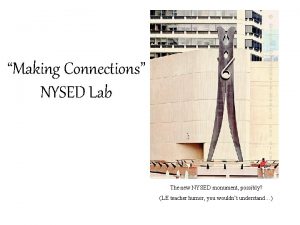Making Connections Developing Learning Resources for Students in

- Slides: 1

Making Connections: Developing Learning Resources for Students in Dining Room Operation Bannesa Espinal Cruz, Student, Hospitality Management Prof. Karen Goodlad, Assistant Professor, Hospitality Management Analysis of Survey Abstract Have you ever opened a bottle of wine and perhaps interpreted serving it as if you were a fine dining restaurant server? In the department of Hospitality Management at New York City College of Technology, we emphasize providing the best quality of service through a series of hands on experience laboratories. Particularly in Dining Room Operations, faculty focus on providing students every resource possible to execute and become comfortable while providing high quality service. Students with minimal knowledge of wine or those who are yet to work in the industry face difficulty understanding the wine profile and most importantly service standards and skills. This research will gage the level of beverage service knowledge students acquire during their Dining Room Operation course. Topics will include extensive service standards and skills and student’s perception of how learning about beverages and beverage service will help in their future career. Students enrolled in Dining Room Operations were given a survey at the beginning of the semester including questions about mise en place, how to read a wine label, tableside suggestive selling, and how to open and pour a bottle of wine. We believe the research will show that learning about beverage and beverage service will help students become more aware of the value of their beverage education through understanding the professional and technical process of bringing the product to the consumer and its impact on the overall hospitality experience. History and Background The topic of beverage service has long been a part of the hospitality curriculum and is emphasized in various courses, specifically the Dining Room Operation Course is their entry into their beverage studies. It was identified, however, that students were not developing the knowledge and skills to be proficient in service and analysis as well as desired. This information, an assessment was developed to measure students developing knowledge as well as how important they believe beverage knowledge is. From this information an interactive seminar was added to the course. Description of Honors Scholars Project, HMGT 2402 Tableside Suggestive Selling n=73 Correct answer would have equaled 7 responses 3% 1% 4 19% 0 Correct 19% 2 Correct 3 Correct 10% 4 Correct 5 Correct 6 Correct 18% 7 Correct 26% CITY TECH WINERY PARTNERSHIPS Through a partnership with The Julia Child Foundation and The Red Hook Winery, students study wine making at Red Hook Winery. The hands-on learning activities includes fermentation, barrel samples, wine blending and marketing. The resulting wine will be served, in Janet Lefler Dining Room at City Tech by students in the Dining Room Operation course. A total of 73 students surveyed answered this question. 19% of students surveyed were correctly able to name all seven components of suggestive selling. Further analysis shows that 64% of the students surveyed were knowledgeable that taste is an important factor while selling a wine. 50% of students surveyed were aware that the producer should be mentioned while practicing suggestive selling techniques. 1% 7 15% 36% It is with unparalleled support of the Julia Child Foundation and the fine dedication of Red Hook Winery that our wine making sessions are possible. The Julia Child Foundation for Gastronomy and the Culinary Arts provides support for “research in culinary history, scholarships for professional culinary training and internships in food writing, as well as professional development and food literacy programs. ” See the JCF for additional information The Red Hook Winery provides wine making opportunities in an urban setting. Their aim is to bring the region’s grapes to the Brooklyn Waterfront. This allows for great learning opportunities for City Tech Students. They open their doors (and their wine barrels) so that students have learning opportunities in which they are literally engaging from grape to wine to serves. How to Read a Wine Label n=73 Correct answer would have equalled 4 responces 0 Correct 1 Correct 2 Correct 3 Correct 4 Correct I beilve learning about beverage service and tasting techniques will help me in my career n=73 ABOUT THE COURSE This course provides an in-depth evaluation of “New World” viticulture and vinification. Wine making methods, service and laws and regulations of the major wine regions of North America, Australia, New Zealand, Chile, Argentina and South Africa will be studied. Students will taste and evaluate wines. ABOUT THE PROJECT Students enrolled in the Wines of the New World course engage in place-based learning activities focused on vinification practices. These hands on learning activities are designed to prepare tomorrow’s hospitality leaders for success. The hands on process includes working with 41% 50 Students in the Wines of the New World course participate in a service project in which they learn about and make wine to be served in the Janet Lefler Dining Room, creating an opportunity for shared experiences between student across the department. To better prepare students in the Dining Room Operation Course to learn about the wine they will serve, learning materials will be developed and shared with future students. The purpose of the learning material will be to assist students new to beverage service on the significance of the wine they present to guests. Specifically, the region the grapes are grown and the taste profile of the wine, while also emphasizing the student’s role in creating the wine for the college. The development of these materials will be designed to enhance the quality of service and expectations of students in the Dining Room Operation course. 46 45 active fermenters, tasting barrel samples, and blending different wines to make the ones served in the Janet Lefler Dining Room. 40 35 30 25 18 20 15 7 10 5 0 1 0 Stronly Agree Neurtral Disagree Stronly Disagree The graph above shows that 64% of students participating in the survey state that they either agree or strongly agree that learning about beverage service and tasting techniques will help them in their career. A total of 73 students surveyed answered this question. 36% were able to name all four components of a wine label that should be presented to a guest. Further analysis showed that among the four possible answers (grape variety, vintage, producer, region) the students were least aware of the need to state the grape variety when presenting a wine to guests (63%). The answer that was stated most often was “region”, 89% of the students responding to the survey chose this answer. When analyzing the responses of those student who only answered one question correctly, it was identified that 80% of these students answered “region”. Mise en Place n=73 Correct answer would have equalled 6 responces 1% 2% 6% Discussion (what did we learn) After analyzing the data, we can assert that before taking the Dining Room Operations course, students have gaps in their knowledge of table side suggestive selling techniques, how to read a wine label, and the mise en place required to conduct proper wine service. The data directs us to the specific gaps such as mentioning the producer, and vintage of a wine during the selling process, and the need to include a B&B plate as important mise en place. However, the data also provides information about areas of strength for instance students were able to identify that glasses and a wine key are part of the mise en place need for proper wine service, they identified taste as part of the table side suggestive selling process, and knew that stating the region is part of how to properly read a wine label. Literature Review is in Development Conclusion Pending Collection of Additional Data 1 Correct 2 Correct 3 Correct 46% 4 Correct 45% 5 Correct 6 Correct City Tech Red Region: North Fork of Long Island Grapes: 50% Cabernet Franc and 50% Merlot Color: Medium Ruby Description: Medium body with a rewarding amount of tannins and acidity. The blend offers notes of black cherries, vanilla and baking spices with a cornucopia of juicy dark fruits. The wine leaves you with a dry finish, provoking you to want more. Vinification: Small lot fermentation employing spontaneous fermentation. Barrel aged for 12 months in 50% new oak. Serving Suggestions: Enjoy with gamey meats like lamb and quail served with rich red sauce. City Tech White Region: North Fork of Long Island Grapes: Chardonnay Color: Medium straw/light gold Description: The chardonnay offers aromas of peach, melon, and mango. On the palate, it is medium bodied, crisp, and subtle. A rich, and balanced wine. Vinification: The grapes are hand harvested and de-stemmed before they undergo a first fermentation in stainless steel tanks. Serving Suggestions: Ideal with appetizers. Pairs great with salmon, or a light salad. Personal Reflection of Honors Scholars Project A total of 73 students surveyed answered this question. Only 1% of the students were able to identify all necessary mise en place to conduct proper wine service. Further analysis shows that among 6 possible answers (bottle of wine, wine key, ice bucket, beverage napkin, glasses, and B&B plates) 97% of the students knew that they must have glasses to be able to conduct proper wine service while only 3% of the students were aware that they must have a B&B plate to conduct proper wine service. At the beginning of this project, my level of knowledge of wine production and wine blending was minimal. As the project progressed, I was able to learn the details of wine making and how to communicate what I know. For example, I learned the terminology associated with wine regions, grapes, age, color, vinification, and how to describe wine. When I reflect upon this piece I see a challenge, one that I was able to face and learn from. When I started I also did not know about the organizations that are part of the project or how they support and interact with their community. I appreciate that they value education.

